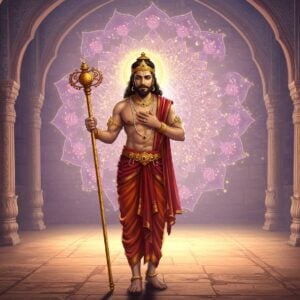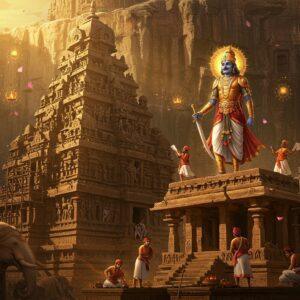
The Ashtavakra Gita, a revered dialogue between the sage Ashtavakra and King Janaka, delves into the profound philosophy of Advaita Vedanta. This ancient text explores the nature of the Self (Atman), the illusion of reality, and the path to liberation. This exploration of the first five chapters will offer insights into self-realization, detachment, and the illusory nature of the material world. For those seeking spiritual wisdom, the Ashtavakra Gita provides a direct and uncompromising approach to understanding existence.
Chapter 1: The Path to Liberation Through Self-Realization
King Janaka’s yearning for liberation initiates the dialogue. His questions about knowledge and freedom prompt Ashtavakra’s profound response: self-realization is the key. This chapter emphasizes the eternal and unchanging nature of the Atman, contrasting it with the temporary nature of the physical body. Recognizing this distinction is the first step towards true freedom.
- Self-Realization: This involves understanding your true self, which exists beyond the limitations of the physical body and mind. It is a journey of inner discovery to recognize your inherent divinity.
- Vairagya (Detachment): Detachment from worldly possessions and desires is presented as crucial for liberation. It emphasizes shifting focus from the external to the internal.
- Guidance of a Guru: The role of a guru, or spiritual teacher, is highlighted as invaluable on the path to self-discovery. A guru provides guidance and support to navigate the complexities of spiritual practice.
- Inner Stillness: Cultivating inner silence and calmness are essential practices. These practices allow the true nature of the self to reveal itself, unobstructed by the noise of the mind.
Chapter 2: Qualities of a Liberated Soul
Ashtavakra describes the characteristics of a liberated being, the “Sthitaprajna,” who possesses a steady intellect and unwavering equanimity. This individual remains unperturbed by the dualities of life, such as pleasure and pain, joy and sorrow.
- Equanimity: Maintaining inner balance amidst the fluctuations of life. It involves responding to situations with calmness and composure, regardless of external circumstances.
- Freedom from Desires: Liberation requires overcoming the pull of desires and attachments. This freedom allows one to experience true contentment, independent of external circumstances. It is a state of inner peace and fulfillment.
- Non-Duality (Advaita): The understanding that the individual self and the Supreme Self are one and the same. This realization leads to a profound sense of interconnectedness and unity.
- The Role of Wisdom: Cultivating wisdom helps transcend the limitations of the ego, enabling the realization of oneness with the universe. It empowers individuals to make choices aligned with their true nature.
Chapter 3: Transcending the Illusion of Maya
This chapter unveils the illusory nature of the world, referring to it as “Maya,” and emphasizes the importance of transcending this illusion. Ashtavakra explains how “Avidya,” or ignorance, perpetuates the false sense of separation between the individual self and the ultimate reality.
- Maya (Illusion): Recognizing the world as a reflection, a temporary manifestation. This understanding helps detach from the illusion of permanence and solidity in the material realm.
- Non-Attachment: Non-attachment becomes the key to freedom from the constantly changing world. This practice allows individuals to engage with life without being bound by its transient nature.
- Self-Inquiry: The practice of self-inquiry helps distinguish between the true self and the non-self. It involves questioning pre-conceived notions about identity and delving into the nature of consciousness.
- Meditation: Meditation serves as a powerful tool to dissolve the illusion of duality and connect with the underlying unity of existence. It quiets the mind and allows for deeper self-reflection.
Chapter 4: Understanding the True Self (Atman)
Chapter 4 delves into the essence of the Atman. Ashtavakra explains that the true self exists beyond birth and death, untouched by the limitations of the body and mind. It is pure consciousness, the silent witness that observes without attachment.
This eternal self resides beyond the constraints of time and space. True liberation arises from recognizing this unchanging nature. The self is likened to a still lake, undisturbed by the ripples of thoughts and emotions.
A key insight is understanding the self as the witness. This involves observing thoughts and actions without identifying with them. This detachment brings peace and joy, freeing us from the constant fluctuations of emotions.
Surrendering the ego is crucial for self-realization. The ego creates a false sense of separation, making us believe we are limited to the body and mind. Letting go of this false identification reveals the fullness of the true self.
Chapter 5: The World as Divine Play (Leela)
Chapter 5 reveals the world as a divine play, or “Leela,” a constant state of flux and change. Clinging to this ever-shifting reality leads to suffering. The concept of “Viveka,” or discernment, helps us see through this illusion, recognizing the difference between the real and the unreal.
True liberation lies in knowing the self beyond worldly illusions, freeing us from desires and attachments. Cultivating inner detachment brings lasting contentment. It’s about being in the world but not of it, engaging fully while remaining rooted in one’s true nature.
The teachings guide us to separate from the body and mind in daily life. This connection with the eternal self brings profound peace and fulfillment. The Ashtavakra Gita encourages us to move beyond the confines of illusion and embrace our true essence.
Shop Sacred Texts and Study Materials on Poojn.in
Poojn.in offers a wide selection of authentic spiritual resources to support your exploration of the Ashtavakra Gita:
- Sanskrit Texts: Original Sanskrit versions with clear printing and high-quality paper.
- Translations and Commentaries: Authentic translations in Hindi and English accompanied by detailed commentaries from respected scholars.
- Study Guides: Companion books explaining key concepts and verses from Chapters 1-5, enhancing your comprehension of the text.
- Complete Sets: Comprehensive collections including the main text and supplementary materials for in-depth study.
- Digital Downloads: Convenient eBook versions are available for access on your devices.
All items are securely packaged for safe shipping. Our customer service team is available to assist you in selecting the appropriate study materials. Visit www.poojn.in or call +91-79085-48235 to place your order. We offer delivery across India with tracking.
Note: Product availability may vary. Please check our website for the latest stock information and pricing.
Embracing Liberation and Eternal Truth
Exploring Chapters 1-5 of the Ashtavakra Gita is a journey towards understanding and liberation. Ashtavakra’s teachings reveal the eternal nature of the self, transcending the ever-changing world. By recognizing our true nature, we discover inner peace and joy.
Chapter 4 highlights the significance of recognizing the self as the silent witness. It encourages detachment from the ego, allowing us to experience the fullness of our true being. This awareness cultivates tranquility, as we observe life’s fluctuations without being swept away.
In Chapter 5, the concept of the world as “Leela” teaches discernment. It emphasizes the impermanent nature of worldly desires and attachments. Through detachment, we experience contentment, engaging with life’s experiences without being consumed by illusions.
These chapters inspire us to embrace our eternal truth and offer a path to live freely, grounded in self-knowledge. The wisdom of Ashtavakra empowers us to transcend illusions and embrace a life of peace and fulfillment.
Mindfulness Meditation: This Is How You Cultivate Present Moment Awareness
The Bhagavad Gita’s Impact on Modern Life: Practical Wisdom for Daily Living
Jyotisar: The Bhagavad Gita’s Origin – A Journey of Exploration
Jyotisar Sarovar: A Spiritual Journey – History, Significance & Serenity


